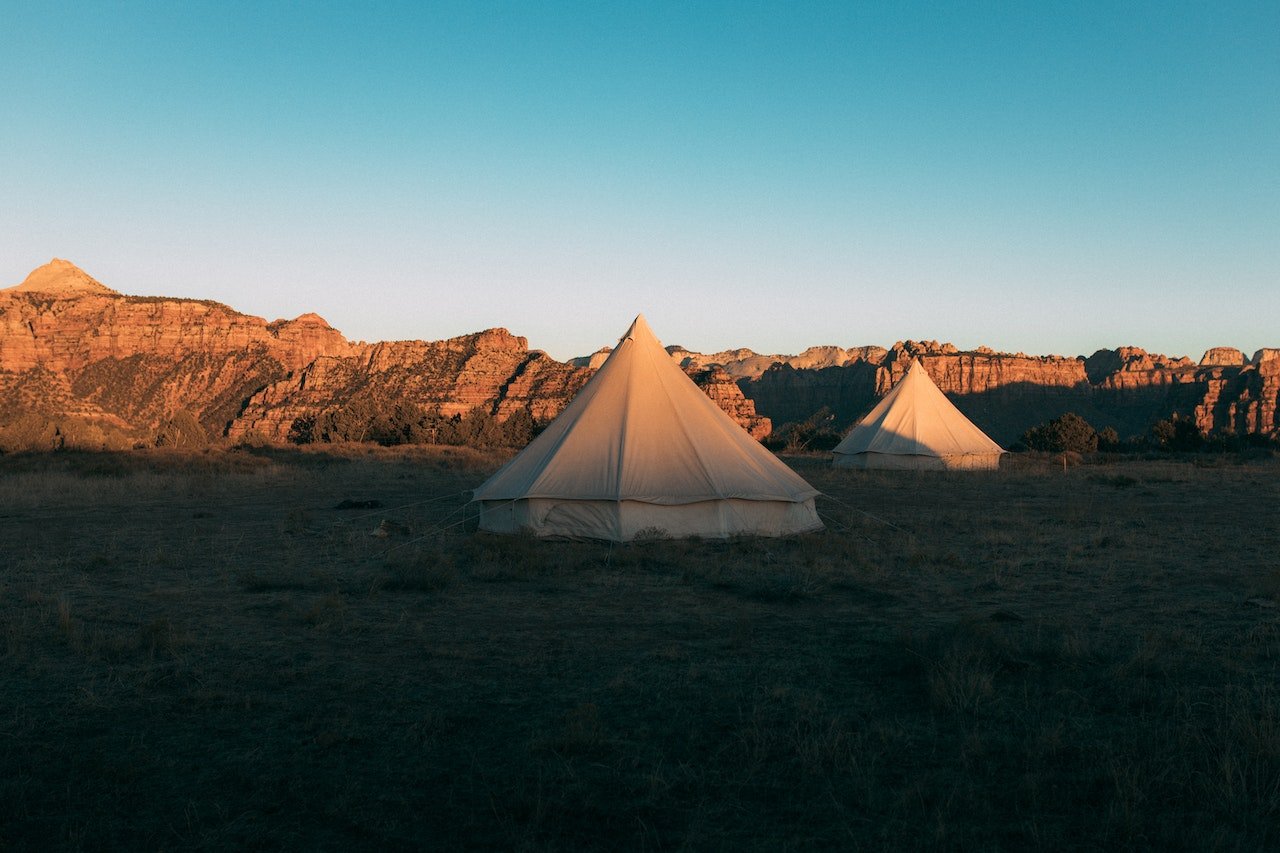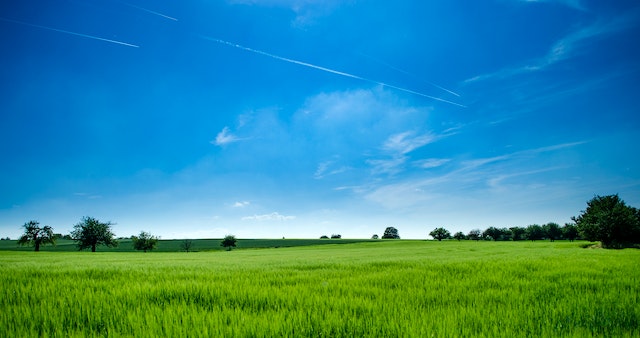Buying Land For Glamping - The Ultimate Guide
Created by Nick Purslow Published on

Reading this article gives you access to a $100 discount, but the long-term benefits will be far greater than that. Read the final section to discover how you can save $100. Read everything else to discover how to find your dream glamping property.
Note: We're building luxury glamping resorts, and you can invest in these projects with as little as $100. Interested in learning more? Just fill out this form and we'll be in touch.
The Essentials When Buying Land for Glamping
This article is going to teach you about a lot of things you probably weren’t aware of in your search for land suitable for glamping. You’ll learn about zoning, floodplains, easements and more later on. It's part of our wider series on how to start a glamping business, which is essential reading for any glamping startup.
But let’s keep things simple to start with. While all the technical stuff is important, you shouldn’t lose sight of the fact that your glampground should be in a desirable location with some attractive features. These are the bare essentials, which we’ll cover briefly now.
Essential #1 - Location
To operate a profitable glamping business, your site needs to be accessible to a large number of people. Unless your offering is truly spectacular, buying land six hours from the nearest metropolitan area probably isn’t going to cut it. Try to find a property no more than a couple of hours away from a reasonably sized city. It’s so much easier to attract guests when they can hop in the car and reach you quickly and easily.
The alternative is to create a glamping business so jaw-droppingly awesome that guests will be determined to stay with you no matter the distance or cost. It’s certainly possible, but it’s a lot harder than choosing a good location.
Essential #2 - Features
Essential #1 becomes completely pointless if the land you choose for your glamping business is a dump. Nobody’s going to want to stay at a site without a nice view. Or where it smells worse than a porta potty at Coachella.
When buying land for glamping, try to find properties with at least one attractive feature. That could be a nice view of the landscape, a cool water feature, a wooded area or anything else that guests can’t experience in their boring suburban neighborhood. Remember, glamping is all about allowing your guests to experience nature in a unique setting. Don’t forget this on your property search.
Red Flags When Buying Land for Glamping
.jpg?width=568&name=Red%20Flag%20(3).jpg)
Now we’ve covered the stuff that you probably already knew, it’s time to dig into the more niche issues that you may not have considered when buying land for a glamping business. These are the red flags to be aware of. They’re not necessarily all dealbreakers, but you need to know the issues each red flag presents before committing to a purchase.
Red Flag # 1 - Unsuitable Zoning
This is the big one. If your property doesn’t have the right zoning for a glamping development, it’s going to be extremely difficult to get your project off the ground. Checking your zoning is a complex process that requires hours of research, and it requires its own blog to do it justice. That's why we’ve written a handy guide on how to make sure you have the right zoning for glamping.
Alternatively, just book a free consultation with us and we’ll tell you everything you need to know.
Red Flag #2 - HOAs
While I’m sure HOAs have their uses, they’re the devil when it comes to any kind of property development. HOAs (short for Homeowners’ Associations) are self-governing organizations to which groups of residential properties belong. Each HOA sets its own rules that its constituents must comply with. While some of these rules are sensible, others are downright ludicrous, and can include the precise height at which each property’s grass must be kept!
Before committing to a property for your glamping business, you should check if it belongs to an HOA. If it does, you should seriously consider looking elsewhere, as it could make things difficult when you attempt a commercial project. The good news is that HOAs are more common in residential neighborhoods than rural areas, with the latter being where you’re most likely to buy land for glamping. However, don’t just assume that a remote property won’t belong to an HOA. It doesn’t take long to check and it could save you a lot of hassle.
Red Flag #3 - Floodplains
If there are floodplains on your property, it makes it extremely difficult to build in those areas. Your county will almost certainly impose additional regulations on developments on floodplains, and some will simply refuse to allow any kind of development. It’s possible to take a site out of a floodplain, but this is a long and expensive process.
The lesson to take from this? Don’t buy a property if most of it is in a floodplain. Floodplains aren’t an issue if you’ve got plenty of other space on the property to build on, but things become tricky when you’re fighting for floodplain-free space.
Red Flag #4 - Easements/Covenants
When buying land for glamping, you should, where possible, avoid properties where neighbors have rights of way over the land (easements), or where there are restrictions in place that limit what you can do on the land (covenants). The former gives neighbors a say over anything that affects the easement, and the latter may limit your ability to start a glamping business or any other kind of commercial development.
If you’ve discovered your dream property and it does have an easement or covenant in place, make sure you know everything there is to know about them. Find out who holds rights, who you need to speak to and how it will affect your plans before committing to a purchase.
Other Things to Consider When Buying Land for Glamping
Utilities
When we talk about utilities for a glamping business, we mean:
- Water
- Electricity
- Internet
- Drainage
Utility installation is usually one of the biggest, if not the biggest cost associated with starting a glamping business. This is because the properties most suitable for glampgrounds are in rural areas where utilities are generally in short supply.
There are ways of supplying utilities when none exist on the property. Satellite receivers can be installed when there’s no existing internet coverage, and septic tanks and wastewater treatment plants can be used when it’s not possible to connect to a sewer network. Water can often be drawn from wells, but this isn’t guaranteed.
Electricity provision is the hardest problem to solve when there’s no pre-existing supply on the site. You can pay to get a new connection, but this can get ridiculously expensive. Solar power is a potential solution, but it’s not suitable for every location.
You need to be aware of these potential issues before committing to a property. Try to find a property where utilities are already in place, or at least be aware of the costs and logistics associated with arranging new supplies.
Raw Land vs Developed Land

The prospect of raw land can be appealing to a prospective glamping business owner. It gives you complete creative freedom to implement your vision, and there’s something satisfying about taking an empty plot of land and turning it into a great destination. The asking price will generally be lower too, which is a bonus.
Be aware, though, that raw land has its downsides too. You know how we just talked about how a lack of utilities can lead to huge costs and logistical issues? Raw land is far less likely to have existing connections than developed land. The money you saved by buying raw land can quickly be dwarfed by the bill you’re faced with when supplying electricity to your site. You may also need to commission additional surveys to prove to the relevant governing bodies that the land is suitable for a commercial development. These can cost a lot of money and can add further delays to your project.
This doesn’t mean you should ignore raw land opportunities. Far from it. Just don’t be fooled by the asking price. Remember the hidden costs.
Buying vs Renting Land for Glamping
Buying land for glamping can be expensive, especially in hotspots like California. A long-term lease can reduce capital requirements, making your glamping startup more affordable and less reliant on external funding.
There may be limits on what you can do on leased land, however. You may not be able to put permanent structures on the property, and the landowner may restrict how the land is used. Make sure you look into these issues before committing to a contract.
Making Offers Subject to Permitting
Even if you've done your research and you know there's a pretty good chance of developing a glampground on the property you've identified, there are no guarantees. Even if your zoning is favourable, you'll probably still need to submit a conditional use permit application to gain final approval. This is easier said than done, and it's possible your application may be refused if it doesn't meet the county's criteria. Buying land only to have your permit application refused leaves you with a useless property and a burning hole in your wallet.
A potential route around this is to make an offer on the property subject to permitting approval. This means the deal will only go through if your conditional use permit application is accepted by the county. Thus, you avoid the risk of buying a property that you can't build on.
The obvious issue here is that the seller may not be inclined to accept such an offer, as it will mean they have to wait months to find out if the deal will go through or not. But there's no harm in asking, and we've seen it work before. The owner of the Woods of Eden Glampground in Maine made an offer like this, and she's now the owner of a highly successful glamping business on a beautiful property.
How to Find Land for Glamping

You can use mainstream real estate websites, like Zillow, to find land for glamping. You can also use specialist sites like LandWatch, which focuses on rural land for sale. These specialist sites are generally the way to go, as you don't have to sift through pages of residential properties like you do with the mainstream sites.
Realtors can also be a great way of spotting good deals, and their knowledge of the local area can save you from spending hours looking through the listings on the websites discussed above.
A $100 Discount Exclusively For You
If you’ve made it this far, congratulations! Your reward is a $100 discount on a product that will help you find the perfect property.
Before you start looking for properties, you need to make sure you’re looking in the right places. There’s no point spending hours looking for a picturesque parcel in a jurisdiction that doesn’t allow anything remotely glamping-related. Remember Red Flag #1? That’s why it’s important to narrow down your property search by identifying the cities/counties/municipalities that allow for glamping-style developments.
We offer a Multi-County Zoning Screening, which analyses the ordinances of your chosen counties and ranks those counties in order of suitability for your project, all in the form of a readable report. This allows you to discard the areas where your project will never get off the ground, and focus on the areas where a glampground is a real possibility. We’ll also set out the roadmap for what you’ll need to do to legally develop in each county, e.g. the types of permits you’ll need.
In return for reading this blog, we'll take $100 off your final quote. Just email us at contact@glampitect.com to claim your discount.
Here’s what one of our clients said about this product:
Glampitect conducted a multi-county zoning screening for our prospective glamping business and the resulting report was extremely helpful.They sifted through zoning ordinances, called county offices, and provided us with a detailed analysis and clear roadmap. Their report helped us focus our search on the right location, ensured that it would meet all requirements, and provided us with the initial steps we’d need to take to secure the requisite approvals. I highly recommend working with Glampitect to get your glamping business started!
To activate your discounted screening or find out more about the benefits, just email contact@glampitect.com and mention that you’ve read this blog, or book a call with one of our team using the link below.

